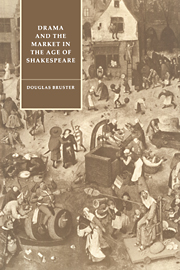Book contents
- Frontmatter
- Contents
- Preface
- Acknowledgments
- A note on texts
- 1 Toward a material theater
- 2 Drama and the age
- 3 “City comedy” and the materialist vision
- 4 Horns of plenty: cuckoldry and capital
- 5 The objects of farce: identity and commodity, Elizabethan to Jacobean
- 6 The farce of objects: Othello to Bartholomew Fair
- 7 “The alteration of men”: Troilus and Cressida, Troynovant, and trade
- Notes
- References
- Index
5 - The objects of farce: identity and commodity, Elizabethan to Jacobean
Published online by Cambridge University Press: 11 September 2009
- Frontmatter
- Contents
- Preface
- Acknowledgments
- A note on texts
- 1 Toward a material theater
- 2 Drama and the age
- 3 “City comedy” and the materialist vision
- 4 Horns of plenty: cuckoldry and capital
- 5 The objects of farce: identity and commodity, Elizabethan to Jacobean
- 6 The farce of objects: Othello to Bartholomew Fair
- 7 “The alteration of men”: Troilus and Cressida, Troynovant, and trade
- Notes
- References
- Index
Summary
sic parvis componere magna solebam
thus it was my habit to compare great things to small ones
Vergil, EcloguesComedy generally, and farce in particular, often feature a misplaced object or objects, the finding of which leads to a recognition and brings on, finally, the story's dénouement. Movable objects like rings, letters, and articles of clothing come to be invested with a narrative value replicating itself uncannily in the larger world of reading and interpretation. Powerful centers of desire, such objects may function as tokens of identity, or parts thereof, dramatically substantiating Georg Simmel's belief that “every possession is an extension of the self, a phenomenon within subjective life, and its whole meaning lies in the conscious and emotional reflexes that are the mind's response to the self's relations to objects.” Objects of this kind can also configure interpersonal relations: frequently signifying the means of resuming a bond between separated characters, sometimes they symbolize and qualify the reason for separation itself. Calling upon the multiple valences that physical symbols can possess for various characters, such objects may emblematize any or all these relations. One of these many valences, of course, is the literal.
- Type
- Chapter
- Information
- Drama and the Market in the Age of Shakespeare , pp. 63 - 80Publisher: Cambridge University PressPrint publication year: 1992



